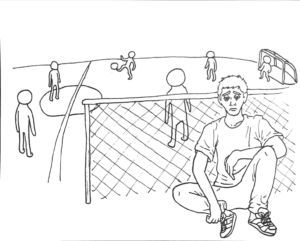The butterflies begin to flutter in the stomachs of student athletes as they jog onto the court. It is the first day of basketball tryouts. High intensity drills, full-speed sprints and competitive play takes place as the players compete, dripping with sweat. The prospects are dedicated, putting forward their best to try to earn a position on the school’s team. On the last day of tryouts, they are called up by the coaches, one by one, to find out their fate. Many will face the harsh reality of high school sports: cuts.
Being cut can be an emotionally challenging experience. However, there is simply no way to avoid it. There is not enough time in a single game for coaches to give all players on a team equal playing time. This is especially true for teams that emphasize winning as a priority and therefore play their most skilled athletes.

Nevertheless, schools should provide students with opportunities to play their respective sports, even if cut from a team. Although there are many alternative options available for students to play club athletics, they are often expensive. Redwood should have opportunities available to participate in athletics for a relatively low price. For example, Redwood could set up a year-round intramural league. This would give all students, regardless of skill level, an opportunity to play a sport.
The less competitive nature of an intramural league would most likely draw more students to participate. Physical Education teacher Mike Dibley hosts an intramural basketball program at lunch every year during the spring season. The league brings together students of all age ranges and skill levels to play against each other in three-on-three basketball games.
Dibley’s intramural league is successful at encouraging students to participate, however this league only lasts for a couple weeks. Having intramural programs like Dibley’s that takes place throughout the year after school hours would enable students to compete with other teams on their skill level for a full season. At Carmel High School, there is an intramural sports program open to students, faculty and staff members to play organized basketball, flag football and kickball games after school. Those who already play at the freshman, junior varsity and varsity levels are not allowed to compete in their respective sport in the intramural league. Redwood’s intramural league could adopt a similar program with at least three team sports. The league would include brackets based on competitiveness so teams would be able to compete in the bracket they are most comfortable playing in. This would give all students an opportunity to participate, whether they are involved in school athletics or not.
Providing students with the opportunity to play organized sports could also have positive academic benefits. A study in the Journal of Sports Administration and Supervision by Angela Lumpkin, a professor at Texas Tech University, and Rebecca Achen, a professor at Illinois State University, noted that athletes have lower dropout rates than nonathletes. Out of a sample of 139,394 Kansas high school students, athletes had stronger cumulative GPA scores and ACT scores than nonathletes. The study also noted that twelfth grade athletes had a 97.6 percent average graduation rate compared to an average graduation rate of 88.1 percent for nonathletes. A 2.5 GPA minimum requirement for students in the intramural league would provide an incentive to pass classes so they may participate with their team.
Athletics have also been noted to build character and strong, hardworking ethical values that may be utilized in everyday life. Team sports emphasize time management skills, discipline and good sportsmanship, all of which may be applied to time off the playing field. Moreover, the ability to work well in a group setting is useful in employment, where individuals sometimes need to work together to be successful.
All students should be given an opportunity to participate in some form of school-sponsored athletics. Participating in school athletics provides students an opportunity to learn crucial life skills and strong ethics that may prove to be beneficial in and out of the classroom. If the proposed intramural league proved effective in garnering student participation, the league could expand to the greater community by encouraging students from other schools to play in the league. An opportunity like this would introduce light competition between different student bodies and the positive benefits team sports display could be shared beyond the Redwood community. This league would have the potential to be competitive and fun, while providing all students an opportunity to participate in school-sponsored athletics.






